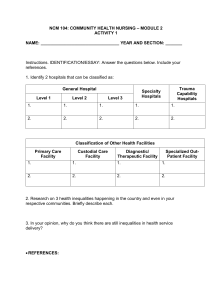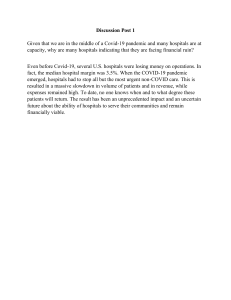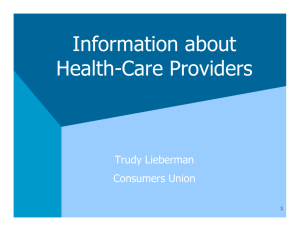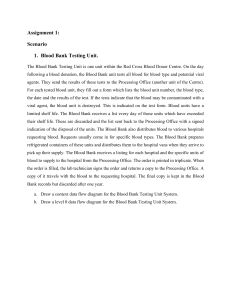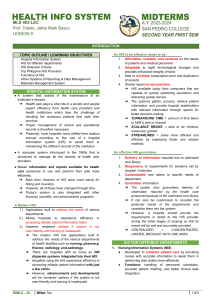Hospital Information Systems: Lesson on HIS Functions & Providers
advertisement
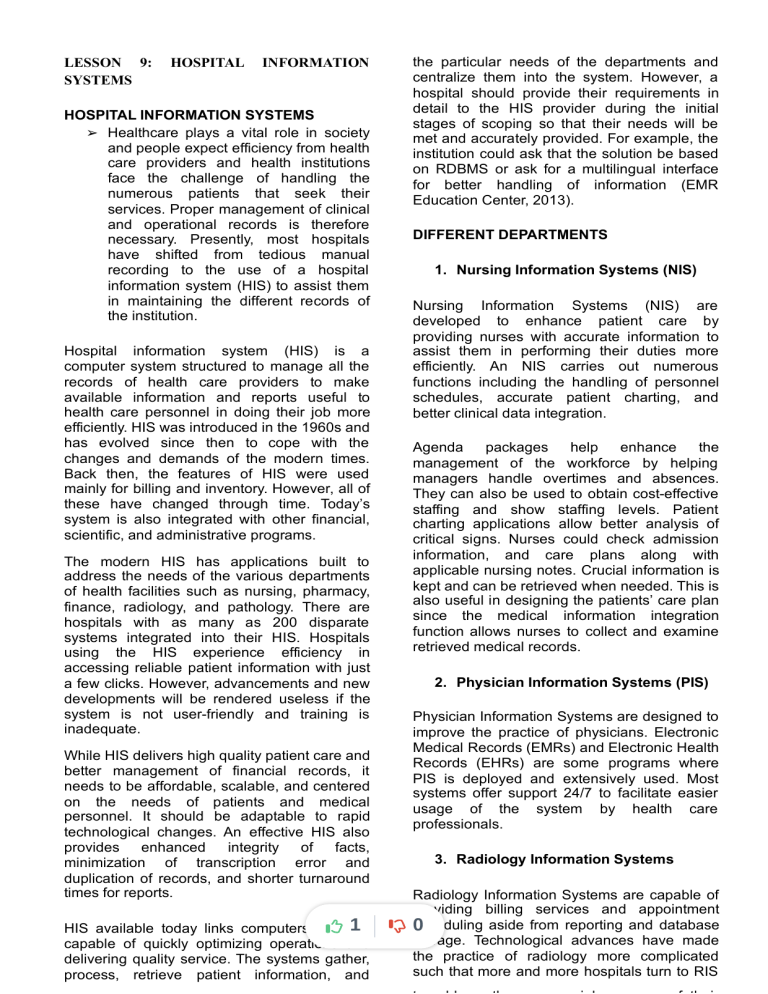
LESSON 9: SYSTEMS HOSPITAL INFORMATION HOSPITAL INFORMATION SYSTEMS ➢ Healthcare plays a vital role in society and people expect efficiency from health care providers and health institutions face the challenge of handling the numerous patients that seek their services. Proper management of clinical and operational records is therefore necessary. Presently, most hospitals have shifted from tedious manual recording to the use of a hospital information system (HIS) to assist them in maintaining the different records of the institution. Hospital information system (HIS) is a computer system structured to manage all the records of health care providers to make available information and reports useful to health care personnel in doing their job more efficiently. HIS was introduced in the 1960s and has evolved since then to cope with the changes and demands of the modern times. Back then, the features of HIS were used mainly for billing and inventory. However, all of these have changed through time. Today’s system is also integrated with other financial, scientific, and administrative programs. The modern HIS has applications built to address the needs of the various departments of health facilities such as nursing, pharmacy, finance, radiology, and pathology. There are hospitals with as many as 200 disparate systems integrated into their HIS. Hospitals using the HIS experience efficiency in accessing reliable patient information with just a few clicks. However, advancements and new developments will be rendered useless if the system is not user-friendly and training is inadequate. While HIS delivers high quality patient care and better management of financial records, it needs to be affordable, scalable, and centered on the needs of patients and medical personnel. It should be adaptable to rapid technological changes. An effective HIS also provides enhanced integrity of facts, minimization of transcription error and duplication of records, and shorter turnaround times for reports. 1 HIS available today links computers that are capable of quickly optimizing operations and delivering quality service. The systems gather, process, retrieve patient information, and the particular needs of the departments and centralize them into the system. However, a hospital should provide their requirements in detail to the HIS provider during the initial stages of scoping so that their needs will be met and accurately provided. For example, the institution could ask that the solution be based on RDBMS or ask for a multilingual interface for better handling of information (EMR Education Center, 2013). DIFFERENT DEPARTMENTS 1. Nursing Information Systems (NIS) Nursing Information Systems (NIS) are developed to enhance patient care by providing nurses with accurate information to assist them in performing their duties more efficiently. An NIS carries out numerous functions including the handling of personnel schedules, accurate patient charting, and better clinical data integration. Agenda packages help enhance the management of the workforce by helping managers handle overtimes and absences. They can also be used to obtain cost-effective staffing and show staffing levels. Patient charting applications allow better analysis of critical signs. Nurses could check admission information, and care plans along with applicable nursing notes. Crucial information is kept and can be retrieved when needed. This is also useful in designing the patients’ care plan since the medical information integration function allows nurses to collect and examine retrieved medical records. 2. Physician Information Systems (PIS) Physician Information Systems are designed to improve the practice of physicians. Electronic Medical Records (EMRs) and Electronic Health Records (EHRs) are some programs where PIS is deployed and extensively used. Most systems offer support 24/7 to facilitate easier usage of the system by health care professionals. 3. Radiology Information Systems Radiology Information Systems are capable of providing billing services and appointment scheduling aside from reporting and database 0 storage. Technological advances have made the practice of radiology more complicated such that more and more hospitals turn to RIS provide hospital stakeholders with relevant information through reports for better decision making. The system also guarantees delivery of information required by the health care personnel because of the optimized core library. It can also be customized to consider 1 to address the commercial concerns of their radiology departments. 4. Pharmacy Information Systems Pharmacy Information Systems help monitor 0 the utilization of medicines in health institutions. The system also handles information on medication-related complications and drug allergies of patients. It provides information to identify drug interactions which helps in administering the appropriate drugs by considering the physiological conditions of the patient. (EMR education center, 2013). SELECTING A HOSPITAL INFORMATION SYSTEM The following are the aspects needed to be considered in selecting an HIS (EMR Education Center 2013) : 1. Total cost of package. HIS is available for all sizes and budgets. For hospitals with smaller budgets, providers may reduce upfront and maintenance fees by using a design that requires fewer servers and hardwares. 2. Web-based system. The system is available on the internet which means that authorized personnel can access the information anywhere and anytime. It also allows data sharing between hospitals. A hospital with updated patient history in its system can facilitate access to information from other health facilities upon request. 3. Implementation and support. During the deployment or upgrade of the HIS, it is imperative that the vendor provides ample training and assistance to the users of the system. Consider vendors that offer 24/7 support through telephone or web services. (EMR Education Center, 2013). HIS PROVIDERS IN THE PHILIPPINES 1. BIZBOX - BizBox, Inc. was founded twentyfive years ago. Its very first hospital project was completed in 1994. The goal of the company is to improve work efficiency in health care institutions through software systems, and to produce advanced solutions for better patient care. Aside from being a certified Microsoft Gold Partner, they have also received the Independent Software Vendor (ISV) of the Year Award. They have fully integrated systems such as Electronic Health Records (EHR) and 1 Document Management System (DMS) that will streamline tasks and help provide better health services (BizBox, 2017). for hospitals and MEDSCHO for schools provide integrated, comprehensive, and proven solutions for efficient health care practices. 3. COMLOGIK - Comlogik Business Systems, Inc. is a Philippine-based software development company that was established in 1999, with a vision to be a global technology company. Comlogik led the way in developing innovative applications like online hospital services where patients can access their billings and examination results, while the administrators can access reports and the doctors can access patients’ records anywhere and anytime. HIS FUNCTIONS 1. Help Desk. The help desk becomes more efficient through the HIS because the manual retrieval of information is no longer needed. Clients can be provided information and guidelines associated with a company’s or institution’s products and services without any hassle. 2. Scheduling. Managers and employees can access work schedules from anywhere they are and effectively discuss their scheduling preferences through the HIS. An employee scheduling software helps save time and makes employee scheduling less difficult. 3. Patient registration. The HIS patient registration form records the name, age, gender, marital status, and other relevant information regarding the patient. These pieces of information are used for record keeping and account management purposes. This form is usually filled out during the patient’s visit or consultation but if the patient is unable to complete the form due to the need for prompt medical attention, the form can be filled out by a relative or guardian. 4. Admission. Before a patient is admitted to a health facility, an admissions counselor will call him or her to gather preliminary information, offer vital information concerning the hospital stay, and answer questions if there are any. Additionally, the physician may also schedule recurring medical exams, such as laboratory tests or X-rays, before hospitalization. Other routine tests can also be carried out on the day of admission. All these can be done more efficiently through the HIS. 5. Discharge. Through the HIS, instructions 0 that accompany a patient’s discharge or transfer are more efficiently provided. These instructions may include discharge planning 2. KCCI MEDSYS - Kaiser-dela Cruz Consulting, Inc. specializes in application development for hospitals, industrial clinics, and medical-related educational institutions in the Philippines. Their products Visual MEDSYS 1 which details services needed to be administered after the hospital stay to ensure the full recovery of the patient. 6. Transfer. The term “transfer” means movement (along with the discharge) of an 0
